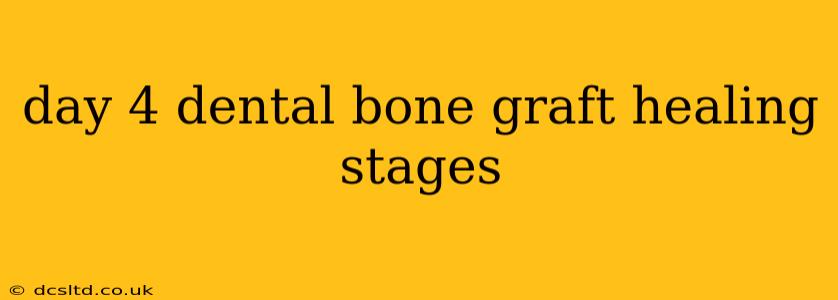Undergoing a dental bone graft is a significant procedure, and understanding the healing process is crucial for a successful outcome. While every patient's experience is unique, this article outlines the typical healing stages you can expect around day 4 post-surgery, addresses frequently asked questions, and provides valuable insights into what to anticipate during your recovery. Remember, this information is for general knowledge and doesn't replace professional advice from your dentist or oral surgeon.
What Happens on Day 4 After a Bone Graft?
By day 4, the initial swelling and discomfort from the surgery should be starting to subside, although some soreness will likely persist. The surgical site will probably still be tender to the touch, and you might experience some bruising or discoloration. You may still be on prescribed pain medication, but the intensity of the pain should be reducing. At this stage, the focus is on meticulous aftercare to promote healing and minimize complications.
What Should I Expect in Terms of Pain and Swelling?
Pain and swelling are normal during the initial healing stages after a dental bone graft. However, the level of discomfort varies considerably between individuals. While some may experience only mild soreness, others might feel more significant pain. It's vital to contact your dentist immediately if your pain is severe, unmanageable despite medication, or worsens unexpectedly.
How long will the swelling last?
Swelling typically peaks around 2-3 days post-surgery and gradually reduces over the following week or two. However, some residual swelling might persist for several weeks. Applying ice packs regularly, as instructed by your dentist, can help manage swelling and discomfort.
What pain medication should I use?
Your dentist or oral surgeon will prescribe pain medication tailored to your specific needs. Follow their instructions carefully regarding dosage and frequency. Never exceed the recommended dose. Over-the-counter pain relievers like ibuprofen can be helpful for managing mild to moderate pain, but always check with your dentist before taking any medication, especially if you have other health conditions.
What Does the Graft Site Look Like on Day 4?
On day 4, the graft site will likely appear somewhat inflamed and possibly bruised. There might be some slight bleeding or oozing of a small amount of blood-tinged fluid. The area will probably be covered with sutures or stitches, and there may be some visible swelling extending beyond the immediate surgical site. Do not attempt to remove the sutures yourself; your dentist will remove them at the appropriate time.
Will I have stitches?
Whether or not you have stitches will depend on the type of bone graft procedure performed and your individual circumstances. Some procedures may not require stitches.
What if I see signs of infection?
Signs of infection can include increased pain, swelling, redness, warmth to the touch, pus, or fever. If you notice any of these signs, contact your dentist or oral surgeon immediately. Early intervention is crucial in managing any potential infection.
What Should I Be Doing to Promote Healing?
Following your dentist's post-operative instructions is paramount for successful healing. This typically includes:
- Maintaining excellent oral hygiene: Gently rinse your mouth with a prescribed antimicrobial mouthwash.
- Following a soft food diet: Avoid hard, crunchy, or chewy foods that could dislodge the graft or cause further irritation.
- Avoiding smoking and alcohol: These substances hinder the healing process.
- Keeping the surgical site clean and dry: Avoid touching or picking at the site.
- Taking prescribed medication as directed: Adhere to your medication schedule precisely.
- Resting adequately: Give your body time to heal.
By adhering to these instructions, you greatly increase the likelihood of a smooth recovery and successful bone graft healing. Remember to contact your dental professional with any concerns or if you experience unexpected symptoms. Their guidance will ensure the best possible outcome for your dental health.
